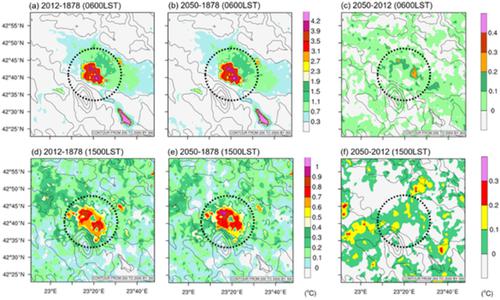当前位置:
X-MOL 学术
›
Meteorol. Appl.
›
论文详情
Our official English website, www.x-mol.net, welcomes your
feedback! (Note: you will need to create a separate account there.)
How urban growth changes the heat island effect and human thermal sensations over the last 100 years and towards the future in a European city?
Meteorological Applications ( IF 2.3 ) Pub Date : 2021-08-08 , DOI: 10.1002/met.2019 Lidia Lazarova Vitanova 1, 2 , Hiroyuki Kusaka 2 , Quang‐Van Doan 2 , Shyamantha Subasinghe 3
Meteorological Applications ( IF 2.3 ) Pub Date : 2021-08-08 , DOI: 10.1002/met.2019 Lidia Lazarova Vitanova 1, 2 , Hiroyuki Kusaka 2 , Quang‐Van Doan 2 , Shyamantha Subasinghe 3
Affiliation

|
Urban development exacerbates urban heat island effects of cities and thermal discomfort of the residents worldwide. However, such urban effects vary with the geographical and climatic conditions of the respective cities. This study is the first to quantitatively estimate the impact of past (1878), present (2012), and future (2050) urbanization on surface air temperatures and human thermal comfort in Sofia, the largest city of Bulgaria. We used the state-of-the-art Weather Research and Forecasting (WRF) climate model, with a 1-km horizontal resolution for three cases: LU1878, LU2012, and LU2050. We first validated the results of the control simulation (case LU2012) against actual observations. The model satisfactorily reproduced the diurnal variation of the observed monthly mean surface air temperatures for July (2011–2013) with a mean bias of ±0.6°C. We then estimated the potential impacts of past and future urbanization on surface temperature. Our results suggest that because of urbanization of Sofia, the surface air temperature at 0600 Local Standard Time (LST) has increased approximately 4.0°C in the past (1878–2012) and approximately 0.4°C in future (2012–2050). We also evaluated the impact of the urban thermal environment on human comfort levels. Considering the LU2050 case in the central part of Sofia, the temperature–humidity index during mid-afternoon (1400–1700 LST) is estimated to be 24–26, indicating that approximately 50% of the residents could feel perceptibly uncomfortable.
中文翻译:

欧洲城市过去 100 年来以及面向未来的城市发展如何改变热岛效应和人类热感觉?
城市发展加剧了城市的城市热岛效应和全球居民的热不适。然而,这种城市效应因各个城市的地理和气候条件而异。本研究首次定量估计了保加利亚最大城市索非亚过去(1878 年)、现在(2012 年)和未来(2050 年)城市化对地表气温和人体热舒适度的影响。我们使用了最先进的天气研究和预测 (WRF) 气候模型,三个案例的水平分辨率为 1 公里:LU1878、LU2012 和 LU2050。我们首先根据实际观察结果验证了控制模拟(案例 LU2012)的结果。该模型令人满意地再现了 7 月(2011-2013 年)观测到的月平均地表气温的日变化,平均偏差为 ±0。6°C。然后,我们估计了过去和未来城市化对地表温度的潜在影响。我们的研究结果表明,由于索非亚的城市化,当地标准时间 (LST) 0600 时的地表气温在过去(1878-2012 年)增加了约 4.0°C,在未来(2012-2050 年)增加了约 0.4°C。我们还评估了城市热环境对人类舒适度的影响。考虑到索非亚中部的 LU2050 案例,下午中旬(1400-1700 LST)的温湿度指数估计为 24-26,表明大约 50% 的居民会感到不舒服。当地标准时间 (LST) 0600 时的地表气温在过去(1878-2012 年)增加了约 4.0°C,在未来(2012-2050 年)增加了约 0.4°C。我们还评估了城市热环境对人类舒适度的影响。考虑到索非亚中部的 LU2050 案例,下午中旬(1400-1700 LST)的温湿度指数估计为 24-26,表明大约 50% 的居民会感到不舒服。当地标准时间 (LST) 0600 时的地表气温在过去(1878-2012 年)增加了约 4.0°C,在未来(2012-2050 年)增加了约 0.4°C。我们还评估了城市热环境对人类舒适度的影响。考虑到索非亚中部的 LU2050 案例,下午(1400-1700 LST)的温湿度指数估计为 24-26,表明大约 50% 的居民会感到不舒服。
更新日期:2021-08-09
中文翻译:

欧洲城市过去 100 年来以及面向未来的城市发展如何改变热岛效应和人类热感觉?
城市发展加剧了城市的城市热岛效应和全球居民的热不适。然而,这种城市效应因各个城市的地理和气候条件而异。本研究首次定量估计了保加利亚最大城市索非亚过去(1878 年)、现在(2012 年)和未来(2050 年)城市化对地表气温和人体热舒适度的影响。我们使用了最先进的天气研究和预测 (WRF) 气候模型,三个案例的水平分辨率为 1 公里:LU1878、LU2012 和 LU2050。我们首先根据实际观察结果验证了控制模拟(案例 LU2012)的结果。该模型令人满意地再现了 7 月(2011-2013 年)观测到的月平均地表气温的日变化,平均偏差为 ±0。6°C。然后,我们估计了过去和未来城市化对地表温度的潜在影响。我们的研究结果表明,由于索非亚的城市化,当地标准时间 (LST) 0600 时的地表气温在过去(1878-2012 年)增加了约 4.0°C,在未来(2012-2050 年)增加了约 0.4°C。我们还评估了城市热环境对人类舒适度的影响。考虑到索非亚中部的 LU2050 案例,下午中旬(1400-1700 LST)的温湿度指数估计为 24-26,表明大约 50% 的居民会感到不舒服。当地标准时间 (LST) 0600 时的地表气温在过去(1878-2012 年)增加了约 4.0°C,在未来(2012-2050 年)增加了约 0.4°C。我们还评估了城市热环境对人类舒适度的影响。考虑到索非亚中部的 LU2050 案例,下午中旬(1400-1700 LST)的温湿度指数估计为 24-26,表明大约 50% 的居民会感到不舒服。当地标准时间 (LST) 0600 时的地表气温在过去(1878-2012 年)增加了约 4.0°C,在未来(2012-2050 年)增加了约 0.4°C。我们还评估了城市热环境对人类舒适度的影响。考虑到索非亚中部的 LU2050 案例,下午(1400-1700 LST)的温湿度指数估计为 24-26,表明大约 50% 的居民会感到不舒服。











































 京公网安备 11010802027423号
京公网安备 11010802027423号